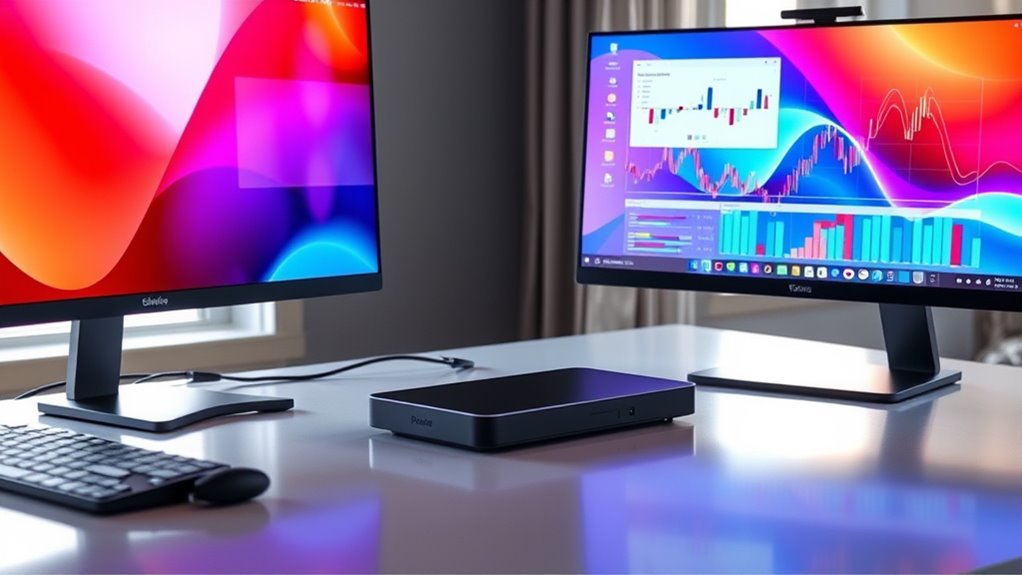To connect two monitors, first, check your graphics card capabilities to confirm it supports multiple displays. Select the appropriate cables based on the monitor connections, such as HDMI or DisplayPort. Connect each monitor to the computer’s output ports and power them on. Then, access your display settings to adjust resolution, orientation, and arrangement. If you encounter issues, verify connections, update drivers, and troubleshoot as needed for peak performance. You can find more detailed steps to enhance your setup.
Understanding Your Computer’s Graphics Capabilities
Before connecting two monitors, it’s essential to understand your computer’s graphics capabilities. The heart of this functionality lies in your graphics card. Make sure it supports multiple displays; most modern graphics cards can handle two or more monitors, but older models may not. Check the specifications of your graphics card to confirm the maximum number of supported monitor types, such as HDMI, DisplayPort, or VGA. Different monitor types may require varying levels of performance, so knowing the capabilities of your graphics card helps you avoid compatibility issues. In addition, be aware of the resolutions each monitor can support, as this impacts overall performance and visual quality. Understanding these aspects will set you up for a successful multi-monitor experience.
Choosing the Right Cables and Adapters
Knowing your graphics card’s capabilities sets the stage for selecting the appropriate cables and adapters for your dual-monitor setup. Start by identifying the cable types your graphics card supports, such as HDMI, DisplayPort, DVI, or VGA. Each cable type has its advantages—HDMI is great for high-definition video, while DisplayPort can handle higher refresh rates and resolutions. If your monitors don’t match your graphics card’s outputs, explore adapter options like HDMI to VGA or DisplayPort to DVI. Confirm the adapters support the desired resolution to avoid limitations. Finally, consider cable length and quality to prevent signal degradation. By choosing the right cables and adapters, you’ll confirm a seamless dual-monitor experience tailored to your needs.
Connecting the Monitors
Once you’ve gathered the necessary cables and adapters, connecting the monitors is a straightforward process. Here’s how to get it done efficiently:
- Identify monitor types: Check if your monitors are HDMI, DisplayPort, or VGA compatible.
- Choose connection methods: Depending on your computer’s output, select the appropriate cable to connect each monitor.
- Connect cables: Plug one end of the cable into your monitor and the other into the computer’s output port. Repeat for the second monitor.
- Power on monitors: Turn on each monitor and verify they’re set to the correct input source.
Configuring Display Settings
After connecting the monitors, the next step is to configure the display settings to optimize your workspace. Start by right-clicking on your desktop and selecting “Display settings.” Here, you can adjust the display resolution for each monitor to guarantee clarity and sharpness based on their specifications. It’s essential to set the proper resolution to achieve the best visual experience. Next, configure the monitor orientation—whether you prefer landscape or portrait mode—for each display. This is particularly useful for tasks like coding or reading long documents. Remember to apply the changes and check if everything appears as intended. With these settings adjusted, you’ll enhance your productivity and enjoy a seamless multi-monitor setup.
Troubleshooting Common Issues
While setting up dual monitors can greatly enhance your productivity, you might encounter a few common issues along the way. Here are some troubleshooting tips for common connection problems and display recognition issues:
Setting up dual monitors boosts productivity, but be prepared for potential connection and recognition issues.
- Check Connections: Verify all cables are securely plugged in and the correct ports are used.
- Update Drivers: Outdated graphics drivers can cause recognition issues; always keep them updated.
- Display Settings: Access your display settings to verify both monitors are detected; adjust resolution if necessary.
- Power Cycle: Sometimes, simply restarting your monitors or computer can resolve connectivity issues.
Frequently Asked Questions
Can I Connect Monitors of Different Sizes and Resolutions?
Absolutely, you can connect monitors of different sizes and resolutions. Just verify monitor compatibility and adjust the resolution settings accordingly for peak performance. You’ll enjoy a flexible workspace tailored to your preferences and productivity.
What Are the Benefits of Using Dual Monitors?
Using dual monitors boosts your productivity considerably and enhances multitasking. You can effortlessly switch between applications, view multiple documents simultaneously, and keep communication tools open, giving you the freedom to work more efficiently and effectively.
Will Connecting Two Monitors Affect My Computer’s Performance?
Connecting two monitors can impact your computer’s performance, depending on resource allocation. If your system’s GPU and RAM can handle the additional load, you shouldn’t notice significant slowdowns, allowing for a more efficient multitasking experience.
Can I Use Two Different Brands of Monitors Together?
Yes, you can use two different brands of monitors together. Monitor compatibility typically isn’t affected by brand differences, as long as they share the same display connections and resolutions. Just make sure your graphics card supports them both.
How Do I Switch Between Monitors Quickly?
You can switch between monitors quickly using monitor shortcuts in your display settings. For Windows, use Windows + P to toggle. Mac users can utilize Command + F1 or adjust settings through System Preferences for swift changes.

